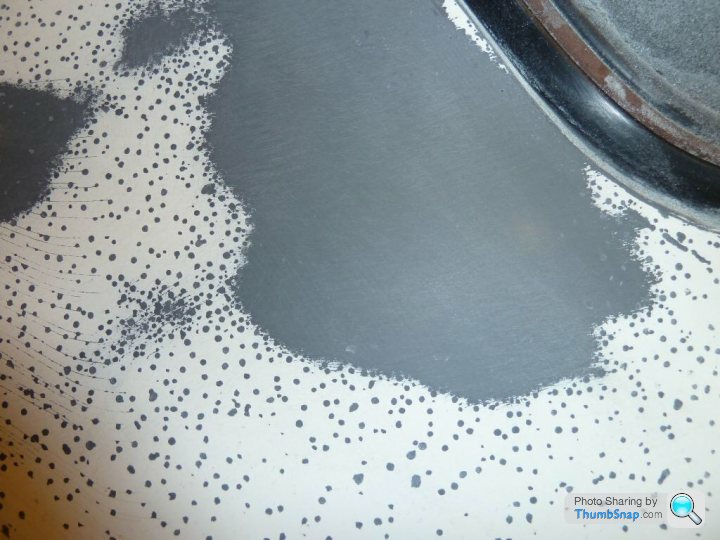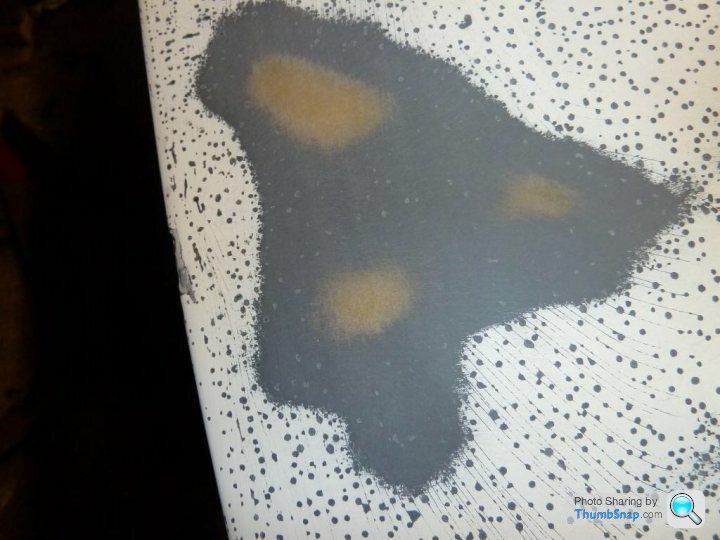Discussion
My 1976 3000M has Pimples everywhere not very nice.
The car has been blown over many times in it's past in various shades of brown.
The last time it looks like it was only paint and no varnish.
I don't think it was even rubbed down to give the paint a key.
I've looked at the Pimples very close and popped a few and there is liquid under each Pimple.
What i plan is to get all the Paint rubbed down to Gel Coat.
Then get it sprayed with a Polyester Filler to seal the surface.
Does that make sense, any comments welcome please
Thanks in advance Boys
Alan
The car has been blown over many times in it's past in various shades of brown.
The last time it looks like it was only paint and no varnish.
I don't think it was even rubbed down to give the paint a key.
I've looked at the Pimples very close and popped a few and there is liquid under each Pimple.
What i plan is to get all the Paint rubbed down to Gel Coat.
Then get it sprayed with a Polyester Filler to seal the surface.
Does that make sense, any comments welcome please
Thanks in advance Boys
Alan
I think what your talking about is known as ‘micro blistering’. I had it severe on my M too. It’s from moisture trapped in the fibre glass or between paint layers, the body work sweats if you like, if it’s in an environment where it can’t breath, such as under a tarpaulin in my case. The moisture is then trapped in the paint layers.
I had to have mine taken all the way back, then baked for a few days to help get rid of any left over moisture before repairing gel coat and tissue layers.
I had to have mine taken all the way back, then baked for a few days to help get rid of any left over moisture before repairing gel coat and tissue layers.
Yes that’s it. Moisture gets into the fibreglass and finds its way out when the car is subjected to hot weather. It can’t go anywhere due to the paint so it forms blisters on the surface. The only cure is to take it back to gel coat and put it in an oven for a couple of days before repainting it.
Just considering how to do this for my tub. So I have been asking around.
Just considering how to do this for my tub. So I have been asking around.
The pimples do not always go down to the gel coat these on my old car didn’t and neither did the cracks you can see in the paint. They can also be solvents that get trapped due to painting before either the FB or filler spray has fully cured. Before you do anything get the car out in the sun and see if they either disapear or reduce. If not have a go at sanding lightly and see where they end hopefully they are just in the top coat. No need to seal the Gel coat but if you do have a respray done don’t wax it for a good couple of months as it can take this long for the Paint to cure and sealing it with a wax can cause blistering
Chris


Chris
Edited by chris52 on Monday 16th April 23:23

Edited by chris52 on Monday 16th April 23:24

Edited by chris52 on Monday 16th April 23:25
Solvent pop is totally different from micro blistering.
Pics in the photos above are micro blistering and do always go back into bare fibreglass...
Personally I would never bake a fibreglass car but storage in a warm damp free ventilated space while restoring the car is extremely important... Similarly good body shops will always cure and dry a new panel before it gets painted... Fibreglass can take 6 months to dry out properly... You often see this on older restorations where car is being stored in less than ideal conditions, Also where a freshly restored car has not been thoroughly dried out before re-finishing and painted..
N.
Pics in the photos above are micro blistering and do always go back into bare fibreglass...
Personally I would never bake a fibreglass car but storage in a warm damp free ventilated space while restoring the car is extremely important... Similarly good body shops will always cure and dry a new panel before it gets painted... Fibreglass can take 6 months to dry out properly... You often see this on older restorations where car is being stored in less than ideal conditions, Also where a freshly restored car has not been thoroughly dried out before re-finishing and painted..
N.
Neil I will have to disagree with you here. The micro blistering in the picture above did not go through the primer at all. My Griff also had micro blistering on some of the panels that had been repainted and these were only the new paint thick and not through to the gel coat. Solvent pop can also look very much like micro blistering but this does tend to only be on new paint or uncured fibre glass. And you can bake a fibre glass car but it’s best to only do so at about 40deg C for a few hours.
Dollyman1850 said:
Personally I would never bake a fibreglass car but storage in a warm damp free ventilated space while restoring the car is extremely important... Similarly good body shops will always cure and dry a new panel before it gets painted... Fibreglass can take 6 months to dry out properly... You often see this on older restorations where car is being stored in less than ideal conditions, Also where a freshly restored car has not been thoroughly dried out before re-finishing and painted..
N.
i always gave fibre glass a good bake at a slightly lower temp with the idea that if i dont heat it up now then the sun will once its parked outside..prefer it to shift at that stage than when its done N.
chris52 said:
Neil I will have to disagree with you here. The micro blistering in the picture above did not go through the primer at all. My Griff also had micro blistering on some of the panels that had been repainted and these were only the new paint thick and not through to the gel coat. Solvent pop can also look very much like micro blistering but this does tend to only be on new paint or uncured fibre glass. And you can bake a fibre glass car but it’s best to only do so at about 40deg C for a few hours.
I spoke to what must be one of the most expensive high end fibreglass paint shops in the country recently. They were looking at £12k to do a complete restoration of the surface, reissue the whole thing bake it and then paint. This was for my Vixen. I was told by them that the best way to do it was to bake the car for several days. Sadly rather out of my price range but a very interesting chat.I do worry about mine because the garage is somewhat damp. I have even considered wrapping the whole thing in plastic sheet and putting a couple of kilos of silica gel in with it. That might be a bit extreme though!
Chris52
i have just rubbed down over Pimples on part of the Bonnet and they are only in the Paint like in your photo.
So i feel a lot happier now.
I think i will make my way over all the body to remove the Pimples so it can be 100% dry.
I have a big dry garage under my House (sous sol total). I can put the car out in the Sun when it is hot and sunny.
I also have a Dehumidifier to be sure the Garage is 100% dry.
I've found that a 5" Orbital Sander using 80 grit seems to work very well.
Looks like Summer will be fun this Year
Alan
i have just rubbed down over Pimples on part of the Bonnet and they are only in the Paint like in your photo.
So i feel a lot happier now.
I think i will make my way over all the body to remove the Pimples so it can be 100% dry.
I have a big dry garage under my House (sous sol total). I can put the car out in the Sun when it is hot and sunny.
I also have a Dehumidifier to be sure the Garage is 100% dry.
I've found that a 5" Orbital Sander using 80 grit seems to work very well.
Looks like Summer will be fun this Year
Alan
Gassing Station | TVR Classics | Top of Page | What's New | My Stuff



